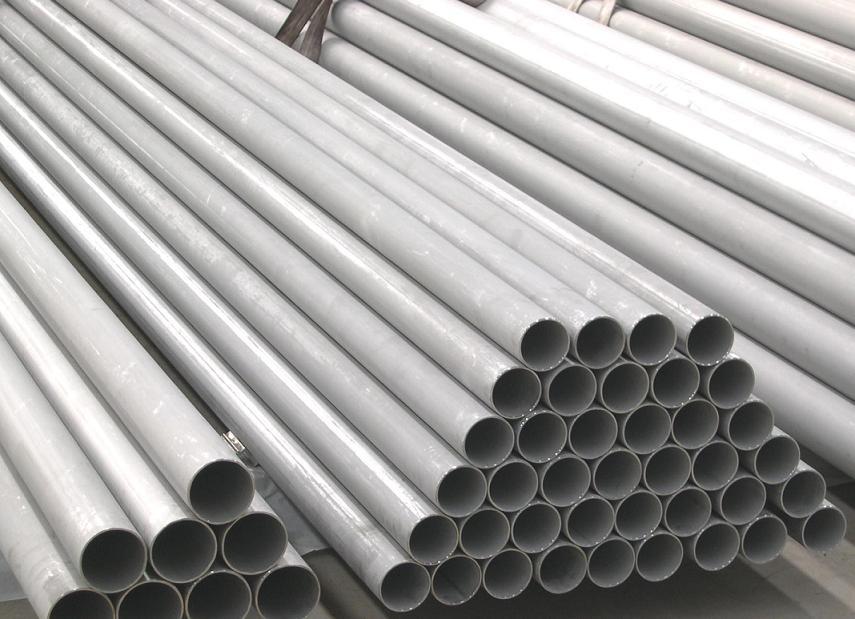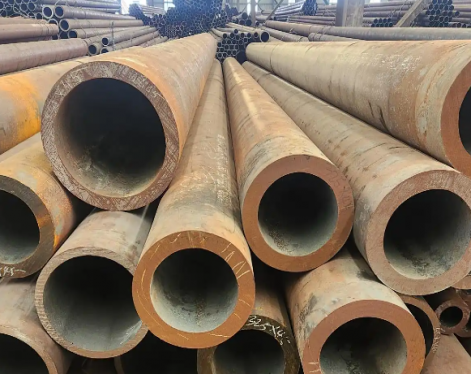Stainless steel seamless pipe is a long strip of steel with a hollow section and no seams around it. The thicker the wall thickness of the product, the more economical and practical it is, and the thinner the wall thickness, the higher its processing cost will be. The corrosion resistance of stainless steel seamless pipe is stronger than ordinary seamless pipe.
Precautions for welding stainless steel seamless pipe
1. The power supply with vertical external characteristics is adopted, and the positive polarity is used for DC (the welding wire is connected to the negative pole)
2. Generally suitable for the welding of thin-walled steel pipes below 6mm, with the characteristics of beautiful weld shape and small welding deformation
3. The protective gas is hydrogen with a purity of 99.99%. When the welding current is 50~150A, the hydrogen flow rate is 8-10L/min, and when the welding current is 150~250A, the hydrogen flow rate is 12-15L/min.
4. The protruding length of the tungsten electrode from the gas nozzle is preferably 4~5mm. In places with poor shielding such as fillet welding, it is 2~3mm. The depth of the groove is 5~6mm, and the distance from the nozzle to the work is generally not more than 15mm.
5. In order to prevent the appearance of welding pores, if there is rust and oil stains on the welding parts, it must be cleaned.
6. The welding arc length is preferably 2~4mm when welding ordinary steel pipes, and 1~3mm when welding stainless steel pipes. If it is too long, the protection effect will not be good.
7. When butt bottoming, in order to prevent the back of the bottom weld bead from being oxidized, the back also needs to be protected by gas.
8. In order to make the hydrogen well protect the welding pool and facilitate the welding operation. The center line of the tungsten electrode and the workpiece at the welding point should generally maintain an angle of 80~85°. The angle between the filler wire and the surface of the workpiece should be as small as possible, generally about 10°.
9. Windproof and ventilation. Where there is wind, please take measures to block the net, and take appropriate ventilation measures indoors.

Determination of Welding Process for Stainless Steel Seamless Pipe
There are many grades of stainless steel. According to the alloy composition, it can be divided into chromium stainless steel and chromium-nickel stainless steel. According to the metal structure of stainless steel pipe, it can be divided into austenite type, ferrite type, martensite type and so on. The most commonly used in construction is austenitic stainless steel seamless pipe. Austenitic stainless steel seamless pipes have better weldability and are relatively easy to weld, and the welded joints have high toughness even in the welded state.However, compared with ordinary carbon steel pipes, its thermal conductivity is about 1/3 of that of carbon steel pipes, and its expansion coefficient is 1.5 times larger than that of carbon steel seamless pipes. Due to the low thermal conductivity and high expansion coefficient of austenitic stainless steel, large deformation and strain will occur during the welding process. Therefore, the welding quality mainly depends on whether the welding process is compatible with the base metal.
Selection of welding methods Common welding methods for stainless steel include manual arc welding, gas shielded welding and automatic submerged arc welding. It is mainly determined according to the designed medium parameters, construction conditions and operating environment, and construction costs. In the construction of process pipelines, due to the different diameters of the pipes and the large number of valves and fittings on the pipelines, the position of the welding joints changes more complicated. Therefore, manual arc welding is generally used.For pipelines conveying flammable, explosive or media with certain cleanliness requirements, hydrogen arc welding is usually used for priming. Manual arc welding is used to cover the surface to improve the internal quality of the weld.
Preparation before welding of stainless steel seamless pipe
Before welding work. Make targeted preparations. This preparation is an important part of ensuring the quality of the weld. Its content is mainly considered from the following three aspects:
1. Confirmation of welding operator skills Welders engaged in welding operations must hold a certificate to work, and must strictly follow the permitted welding items indicated on the operation certificate. Welders preferably have more than two years of experience in welding stainless steel or chromium molybdenum steel
2. Management of welding materials Before using the welding rod, it should be baked according to the instruction manual (if there is no regulation, it should be processed according to the drying temperature of 150~200℃ and the drying time of 1h). Baking must use a special oven with temperature control. You can bake as much as you want, and you can take it as you use it. The dried electrodes should be used in the insulation cylinder. If exposed for more than 2 hours, it should be re-baked. Repeat should not exceed 3 times.
3. The groove of stainless steel pipe can be machined or plasma cut. The oxide layer and burrs at the groove should be removed first. In order to facilitate the removal of spatter after welding, the powder slurry can be painted within 50mm on both sides of the weld, and then removed after welding. Since the contact between stainless steel and carbon steel will produce "carburization", special grinding wheels and stainless steel brushes must be used to clean the weld bead and splash.
Precautions for welding stainless steel seamless pipe
1. The power supply with vertical external characteristics is adopted, and the positive polarity is used for DC (the welding wire is connected to the negative pole)
2. Generally suitable for the welding of thin-walled steel pipes below 6mm, with the characteristics of beautiful weld shape and small welding deformation
3. The protective gas is hydrogen with a purity of 99.99%. When the welding current is 50~150A, the hydrogen flow rate is 8-10L/min, and when the welding current is 150~250A, the hydrogen flow rate is 12-15L/min.
4. The protruding length of the tungsten electrode from the gas nozzle is preferably 4~5mm. In places with poor shielding such as fillet welding, it is 2~3mm. The depth of the groove is 5~6mm, and the distance from the nozzle to the work is generally not more than 15mm.
5. In order to prevent the appearance of welding pores, if there is rust and oil stains on the welding parts, it must be cleaned.
6. The welding arc length is preferably 2~4mm when welding ordinary steel pipes, and 1~3mm when welding stainless steel pipes. If it is too long, the protection effect will not be good.
7. When butt bottoming, in order to prevent the back of the bottom weld bead from being oxidized, the back also needs to be protected by gas.
8. In order to make the hydrogen well protect the welding pool and facilitate the welding operation. The center line of the tungsten electrode and the workpiece at the welding point should generally maintain an angle of 80~85°. The angle between the filler wire and the surface of the workpiece should be as small as possible, generally about 10°.
9. Windproof and ventilation. Where there is wind, please take measures to block the net, and take appropriate ventilation measures indoors.

Determination of Welding Process for Stainless Steel Seamless Pipe
There are many grades of stainless steel. According to the alloy composition, it can be divided into chromium stainless steel and chromium-nickel stainless steel. According to the metal structure of stainless steel pipe, it can be divided into austenite type, ferrite type, martensite type and so on. The most commonly used in construction is austenitic stainless steel seamless pipe. Austenitic stainless steel seamless pipes have better weldability and are relatively easy to weld, and the welded joints have high toughness even in the welded state.However, compared with ordinary carbon steel pipes, its thermal conductivity is about 1/3 of that of carbon steel pipes, and its expansion coefficient is 1.5 times larger than that of carbon steel seamless pipes. Due to the low thermal conductivity and high expansion coefficient of austenitic stainless steel, large deformation and strain will occur during the welding process. Therefore, the welding quality mainly depends on whether the welding process is compatible with the base metal.
Selection of welding methods Common welding methods for stainless steel include manual arc welding, gas shielded welding and automatic submerged arc welding. It is mainly determined according to the designed medium parameters, construction conditions and operating environment, and construction costs. In the construction of process pipelines, due to the different diameters of the pipes and the large number of valves and fittings on the pipelines, the position of the welding joints changes more complicated. Therefore, manual arc welding is generally used.For pipelines conveying flammable, explosive or media with certain cleanliness requirements, hydrogen arc welding is usually used for priming. Manual arc welding is used to cover the surface to improve the internal quality of the weld.
Preparation before welding of stainless steel seamless pipe
Before welding work. Make targeted preparations. This preparation is an important part of ensuring the quality of the weld. Its content is mainly considered from the following three aspects:
1. Confirmation of welding operator skills Welders engaged in welding operations must hold a certificate to work, and must strictly follow the permitted welding items indicated on the operation certificate. Welders preferably have more than two years of experience in welding stainless steel or chromium molybdenum steel
2. Management of welding materials Before using the welding rod, it should be baked according to the instruction manual (if there is no regulation, it should be processed according to the drying temperature of 150~200℃ and the drying time of 1h). Baking must use a special oven with temperature control. You can bake as much as you want, and you can take it as you use it. The dried electrodes should be used in the insulation cylinder. If exposed for more than 2 hours, it should be re-baked. Repeat should not exceed 3 times.
3. The groove of stainless steel pipe can be machined or plasma cut. The oxide layer and burrs at the groove should be removed first. In order to facilitate the removal of spatter after welding, the powder slurry can be painted within 50mm on both sides of the weld, and then removed after welding. Since the contact between stainless steel and carbon steel will produce "carburization", special grinding wheels and stainless steel brushes must be used to clean the weld bead and splash.









